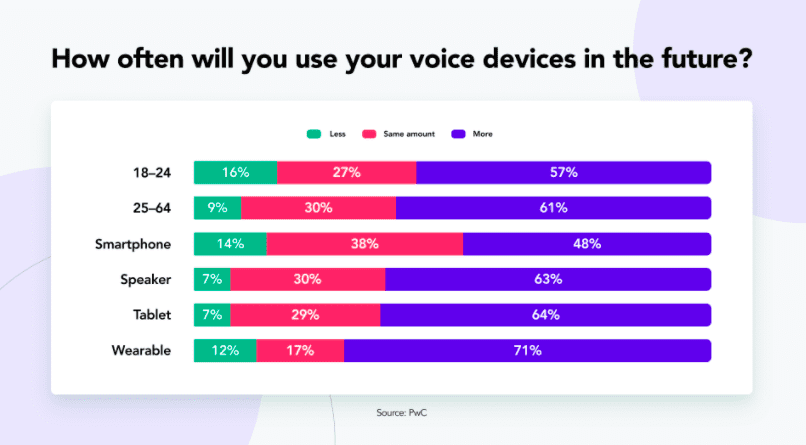It’s easy to see how Apple’s voice assistant amazed smartphone users when it debuted in 2011. Siri’s clear and distinct robotic voice gathered search results in a matter of seconds, surprising mobile users with quick and complete information.
Other companies scrambled to follow suit and provide that same wow factor in their own direct voice recognition software with Google launching their voice search on phones and later Google Home then Amazon bringing Alexa into the world.
These devices and systems are getting smarter at making tasks like researching, scheduling events and meetings, and even listening to audiobooks simpler and more convenient.
As the technology has grown, so has the popularity with 52% of online users utilising voice search on their devices and 93% reporting positive feedback from their interaction.

Voice search also uses artificial intelligence (AI) and search engine optimisation (SEO) to gather information for online users. By recognising keywords or phrases that have “what”, “how”, “when” and “best”, these voice searches are able to gather information that answer the user’s question and collate relevant posts on the internet.
Some businesses have started capitalising on creating keyword-rich content in the form of blogs or videos. By applying SEO techniques to their content they’re able to maximise voice search results and get their content to the top search pages.
For small businesses, making your content discoverable with voice search will help in drawing attention to your website and social media pages, which can later lead to increased brand awareness and better customer recognition.
Why do people use voice search?
Unlike traditional internet searches that require you to open your computer and type in what you’re looking for, voice search is hands-free. That makes it available to people while they are doing other things, like driving, cooking, walking or even jogging.
Using voice search also feels more natural. The spoken word is our most operative and natural method of communication, which not only makes it appealing to use voice prompts because we don’t have to think about it as much, it also makes it much faster to get our request across.
It also saves time overall, as well as speech being a fast form of answering requests, you cut out typing time, and the time it can take you to open search browsers, so you get results back to faster.
Photo Credit: One Chicago via GIPHY
One of the other benefits of using voice search is that it’s multilingual. Google currently has more than 30 major languages on Android devices opening up searches to the user’s preferred language, no matter where they are.
Voice search is continuously growing and evolving. Thanks to efforts made by multiple companies in maximising voice recognition technology, voice search is constantly improving with new features and better recognition, especially when it comes to learning keywords and accents and cutting out background noise.
How does voice search work in content marketing?
Because voice communication is faster and more fluid than typing there has been a shift in content marketing strategies. Now people are searching by asking questions, questions that can be quite long or detailed, whereas typed searches typically aim for the short, sharp subjects.
So a typed search for “Melbourne Weather” would activate different keyword phrases to a voice search for “What is the weather in Melbourne today?”
In terms of Search Engine Optimisation (SEO), marketing strategies that include questions with long-tail keywords are getting better rankings, especially if they provide an immediate answer to the question below it, because they are meeting the growing popularity of voice search patterns.
Search engines recognise keywords in the voice search to find content and return answers that closely match the initial question. It uses SEO to bring you the most relevant websites, videos, or blogs in the search engine result pages (SERPs). For creating quality content and strategies for building your brand, visit copywriting services.
To better understand how this works, it’s important to understand the relationship between SEO and content marketing and how they are used together to drive positive results for businesses.
SEO is the process of using content to increase your website visibility and ranking on the SERPs. By integrating important keywords into your content, you allow search engines to place your posts in the top SERPs, widening your customer reach and gaining better brand recognition in the process.
In order to have your listing show where people are searching for it, you need to structure the same questions people are asking within your content. Because of this unique feature, long-tail keywords work best for catering to voice searches and help in bringing your content to the search engine’s top pages.
To keep up with user searches and maintain quality keywords, marketers and small business owners will need to adjust their content to cater to the new format through:
- Including content that answers specific questions your customers might have. Through thorough research on your target market, you’re able to gather common questions from your customers and address these with your content. This gives you the ability to not only answer a frequently asked question, but to improve your SEO ranking and brand visibility.
- Creating content in a question-and-answer format. By asking the question and applying an immediate answer you allow the search engine to return faster results to a search to a user and help improve your SEO ranking.
- Providing high-quality content. In this incredibly saturated market, you’ll need to make your content stand out from competitors and deliver exactly what users are looking for. By consistently meeting demand with high-quality content you’ll get more people to your site and establish yourself as a person of authority in your industry.
The rise of voice search also challenges businesses to make their content more mobile-friendly. Because the majority of voice searches are done with handheld devices small businesses and marketers will need to make sure their content is readable over mobile.
3 ways to optimise your content for voice search
Now that you have a better understanding of how catering to voice search demand increases SEO rankings, it’s now time to apply these findings to your content marketing strategies to get your business offering up to speed and see results.
Here are three ways you’re able to optimise your content for voice search:
1. Focus on local searches
When using a voice search, most of the time the user is looking for something local. People rely on their mobile devices to find places, like specific shops, restaurants or activities within the immediate vicinity.
According to Google, searches for local stores without the qualifier “near me” have grown 150% over the last two years. Google has counted this by providing searches for places nearby as top rankings. That means as a small business you need to include your local details and have a local focus.
Provide accurate addresses and contact information for your online business and be sure to include the regions you service or deliver to. This allows search engines to recognise your business location and direct people in close proximity towards it.
It also helps to include information such as online reviews, business profiles and operating hours to allow people looking for your business to access the information they need easily or call about an inquiry.
You’ll find that catering to the local market and adding the necessary information will help search engines recognise your small business and open it up to voice search users as well as potentially increasing your SEO.
2. Use long-tail keywords that are popular in voice searches
Voice searches usually take the form of a question which will impact the keywords and phrases that will get the best search return for your business.
Because of this, it helps to integrate specific and commonly used long-tail keywords or phrases into your content. This gives it a better chance of receiving a higher ranking on search engines.
Content formats you can use include frequently asked questions (FAQ), listicles, and even long-form blogs.
You’ll find that by adding longer keywords into your content that are relevant to your business and your customer’s search patterns, you’re able to better cater to those doing voice searches.
3. Make sure your website is mobile-friendly
Since a lot of voice searches are carried out on mobile devices, you’ll need to make sure that people can access your content and website on their phones. If it’s slow, the text is the wrong size, images aren’t loading or the page stretches, you’re giving them a reason to click out and give up.
Make sure your site is optimised to have a mobile-friendly version so that anyone using a mobile device can find what they need quickly-who knows, they may even browse and convert.
As voice search technology increases and improves it’s changing the way we search and when we do our online searching. Business owners can keep up by matching their keywords to customer voice search requests, including creating long-tail questions and phrases that sound more natural and conversational and optimising their business website for mobile devices.
Meeting the needs and demands of your customers starts at the search level. If you are flexible enough to match your content and develop your marketing strategies to follow the trend you will increase your website ranking and brand awareness to win more customers.


